Caryl Hart & Harry Woodgate
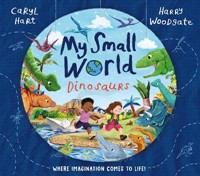
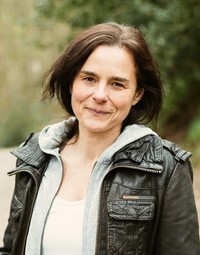
About Author
Caryl Hart and Harry Woodgate's new picture book series, My Small World, encourages wonder and exploration in young children.
Caryl Hart writes picture books and young fiction and loves walking her dog and sitting in cafes and libraries. She runs creative literacy workshops for schools and libraries. She lives in Sheffield with her husband and daughters.
Harry Woodgate writes and illustrates diverse, inclusive stories that inspire young readers to be proud of what makes them unique. Harry loves writing music, cycling, baking, exploring independent coffee shops, botanic gardens and bookstores.
5* Reviews of My Small World: Dinosaurs: 'This is the most wonderful story which is perfect for all young children and will spark their imaginations.'
Interview
My Small World: Dinosaurs (Simon & Schuster Children's Books)
June 2023
The new My Small World series by Caryl Hart and illustrator Harry Woodgate will help develop children's imaginations and creative play, encouraging children in creating their own 'small worlds' and imaginative play. Ideal for both home and the classroom, these stories are bound to end in children in creating and losing themselves in their own imagined worlds.
We asked author Caryl Hart and illustrator Harry Woodgate to tell us more about how they created these books, and how to use the books to inspire further creative work at home and at school.
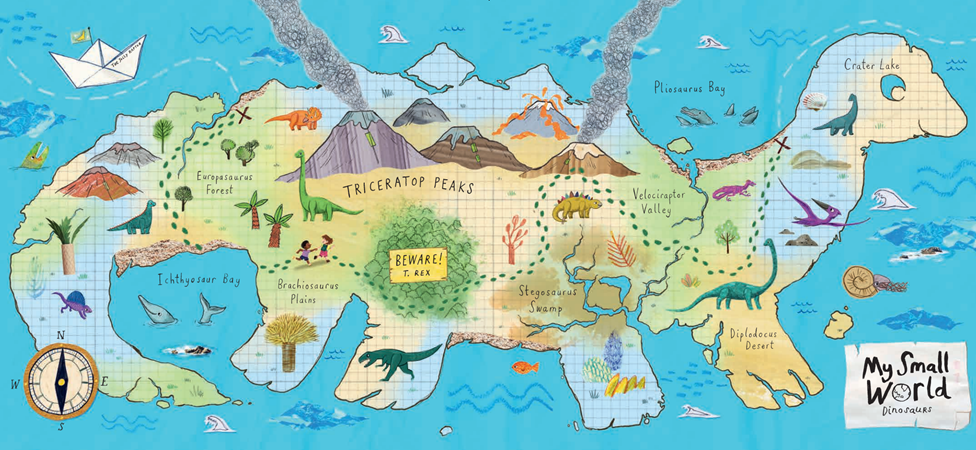
Q&A with Caryl Hart
1. What kinds of picture books do you enjoy creating? Do any books you've written stand out for you in your writing career to date?
I love creating rhyming picture books as I love the way they sound inside my head, and writing in rhyme brings an extra challenge, so when a text works out it can be super-satisfying! I do also love writing in prose, but a lot of my texts just do seem to come out in rhyme.
I think my biggest achievement in terms of rhyming texts is my version of Peter Pan, (Nosy Crow Classics, illustrated by Sarah Warburton) which is written completely in rhyme as a double-length picture book. It was a huge challenge picking out which parts of the original story to include and working out how to keep the magic of the story while telling it in rhyme. We also worked hard to update the language and vibe of the story to ensure it worked for today's diverse society.
Later this year I have a book of ballet stories coming out with Macmillan, illustrated by Briony May Smith. We've worked hard to update the language, concepts and illustrations to bring readers much more inclusive versions of these traditional stories. For example we've created a more diverse range of characters, given female characters more agency, updated gender roles and introduced the concept of consent. Briony's illustrations are phenomenal and really shine out from the pages, so I'm super-excited about this book.
2. What gave you the idea for the Small World picture books?
I launched myself onto Instagram in 2020 and was immediately drawn to all the amazing small world play setups that many play specialists, teachers and parents were creating. Most of what I engage with is centered around books, with a view to helping very young children explore a multisensory world connected with the books' themes.
It feels like a very nurturing and wholesome way to play with your children and to help them develop pre-reading and writing skills and encouraging actual reading and writing development through play. Many members of the book-play community now help me with book launches - as well as reviewing books, they also create some incredible sensory-play setups and craft activities. I feel hugely privileged to be a part of this wonderful community and it was really their work that inspired me to create the My Small World books.
3. Have you created some of your own 'small worlds' to try out the idea of physically making the world you describe in your picture book?
I've spent a lot of time online looking at other people's set ups and researching the best materials to create features such as water, snow, gravel, sand, volcanoes, and other scenery. It's important that all the materials used are non-toxic and preferably edible! Very young children love to explore with their mouths so it's definitely worth finding materials that enable them to do this safely.
I recently ran a workshop for aspiring authors, which included a session on narrative through play. Each group had a paper cup with animal beads, playdough, pompoms and bottle tops. It was amazing to witness some of the wonderful stories that evolved!
I'm hoping to run some My Small World events for children in the near future so will be looking to create my own small world on a large tuff tray, or bring resources so children can make their own.
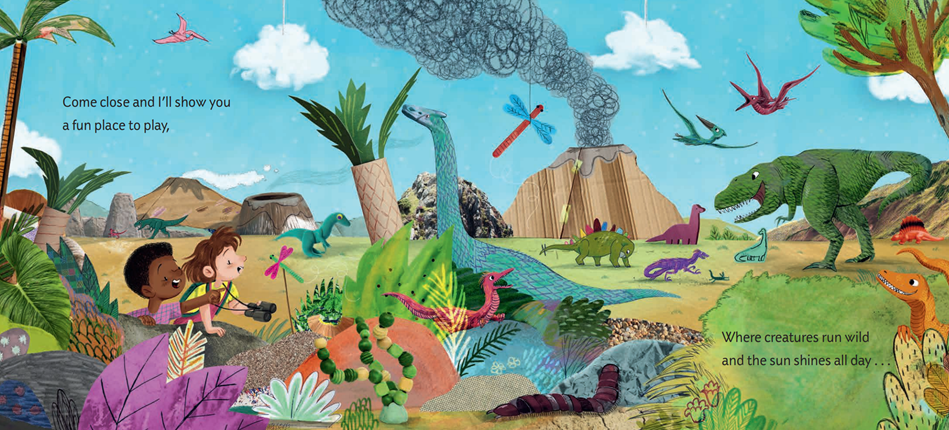
4. Why did you decide to put child characters into the dinosaur world?
Many children become completely absorbed in their games as they play. They often re-enact real or imagined scenarios and give personality to their favoured objects. Cuddly animals, trucks, diggers, sticks and stones - all come to life in a child's imagination. And as they play, children often create stories. Many even narrate these stories out loud as they go along.
If you ask a child what is happening in their game, they will probably be able to describe in great detail what exactly is happening and why. Older children might also do this when playing together with friends. Each might take on a personality and a specific set of behaviours as they act out their chosen character. I feel that these verbal and physical narratives are a crucial step in children's creative development. They form the building blocks for many aspects of life, including creative writing and self-expression.
In the My Small World series, we invite the reader to enter an imagined world of cardboard volcanoes and crepe paper sky hung with cotton wool clouds. As the book progresses, we mix up "real" and "home-made" elements to give the feeling that the reader is inside the play-set. Harry Woodgate has done an incredible job of blending several illustration styles to create a world that feels simultaneously real and imagined. In this way we hope to inspire children, families and teachers to get involved in small world play and understand the value of creating and exploring these environments with their children.
5. The dinosaurs are fabulous - are the stories based on what we know about dinosaurs - and the landscapes they lived in? Do you want a mix of fiction and non fiction in these books?
The book is a real blend of fact and fiction. Each dinosaur has it's own character which is based on fact, but then enhanced with a personality. For example, the child characters in the book meet an Ichthyosaur, which we learn looks like a dolphin but is really a fish-eating lizard. These are facts. However, the children are wearing diving helmets and feed the Ichthyosaur some fish - which is obviously imagined.
Similarly we meet a scary Tyrannosaurus Rex, and learn that it is a meat-eater. But the child characters in the story are safe because the T-Rex gets distracted by a passing butterfly and gives up the chase. So we've really blended fact and fiction to hopefully help children relate to these magnificent creatures and inspire them to learn more about them.
6. What would you like the Small World books to lead on to for young readers and young creators? How do you encourage them in further activities?
I would love to inspire readers to create and play with their own small worlds. There are lots of ideas within the story that children can use, and we've also included an illustrated 'How To' guide at the back, with suggestions and ideas to create your own dinosaur land. We've been careful to use everyday materials that the majority of children will hopefully have access to at home or at school or playgroup - and also given several alternatives for each element. I'm very mindful that so many children have limited resources at home, so wanted to make sure small world play could be made available to everyone.
Harry and I have also created some free activities which can be downloaded from my website. These include instructions on how to make tree ferns and lollipop stick dragonflies as well as inviting children to draw the view through a pair of binoculars, inspired by a spread in the story.
We would love adults to get involved with small world play, as playing together is great bonding time and can lead to some really fantastic discussions and learning on both sides.
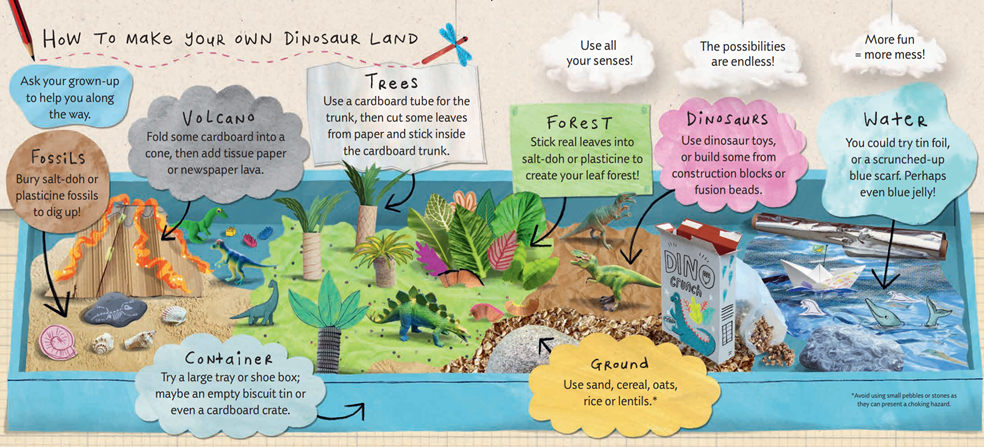
7. Would these books work well in classrooms, as well as homes?
Several early years teachers on social media have already told me they think My Small World Dinosaurs will be brilliant to use in school, especially with younger children. I definitely think it will also be a popular book to read at home and hope that it will help inspire families to spend time together creating imaginary worlds for themselves.
8. What do you think of Harry Woodgate's illustrations for My Small World: Dinosaurs - any favourite spreads?
Well OBVIOUSLY I absolutely love them! Harry has done a stunning job blending real and imaginary elements and I know they put a huge amount of time and effort into creating a wonderfully playful feel to each spread.
I think I have two favourite spreads, one where we are looking through a pair of binoculars from half way up a volcano. We can see lots of different dinosaurs running around below. And my other favourite spread is the pen-ultimate one, where all the dinosaurs are gathered together in front of the setting sun. The dinosaurs are so cute and friendly and the whole scene is really heartwarming!
9. Are you planning more Small Worlds picture books?
Yes! We have two more books in production, each set in a different environment. Both are already written and Harry has created some incredible rough illustrations for book two, which actually made me quite emotional! So there is definitely a lot more to look forward to.
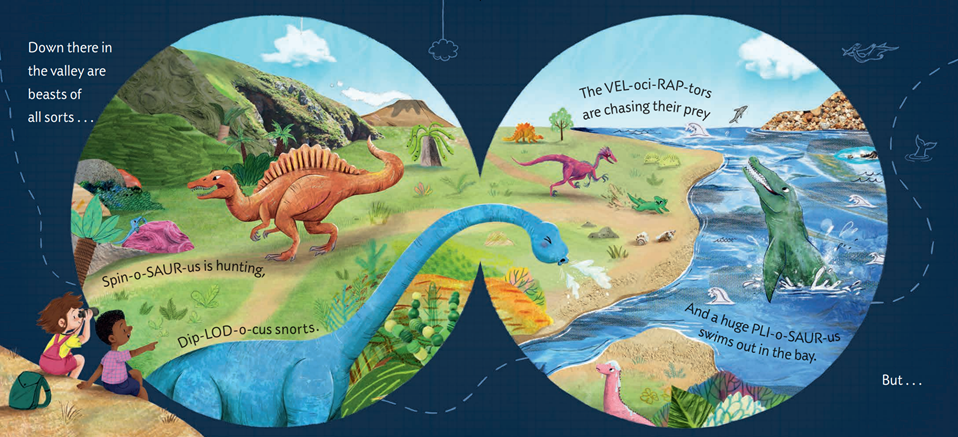
10. What other picture books have you created that children could move on to after My Small Worlds?
Anyone who likes My Small World Dinosaurs might also like my Meet the World series, illustrated by Bethan Woolvin and published by Bloomsbury. To date we have three books: Meet the Planets, Meet the Oceans and most recently Meet the Weather. These are fact-based rhyming books where our reader travels around the world by rocket, submarine or hot air balloon to meet all the different planets, oceans and weather systems, each with their own character. Each characters introduces themselves with a jaunty rhyme so children are learning without even realising!
A parent recently sent me a video of her daughter, sitting in her high chair, reciting all the planet names and telling me which one was her favourite. She was TWO years old! These books are great fun and Bethan's illustrations are really eye-catching and full of personality. Meet the Oceans was one of Waterstones Best Books of 2021 for Babies and Toddlers, and Books for Topics EYFS Best Curriculum Support. Meet the Weather is one of Books For Topics' Top 50 Recommended Reads for reception.
Younger readers might also like my When a Dragon series, illustrated by Rosalind Beardshaw and published by Nosy Crow. To date we have three stories featuring an adorable little dragon and her two human friends. The books explore what might happen when a dragon comes to stay, when she goes to school and when she meets her new baby. Will she share her toys and help out, or will she throw a tantrum and refuse to go to bed?! These books are very relatable and funny - and gently model good behaviour - with utterly adorable illustrations by Ros! We have two more books in the pipeline and board book versions of the first three filtering in this year and next.
Thank you so much for all your wonderful questions and for inviting me to contribute!

Q&A with Harry Woodgate
1. How did you become and illustrator and what kinds of books do you enjoy illustrating? What have been the stand-out moments in your career?
I've always loved reading and drawing, and decided I wanted to be an author and illustrator way back in nursery school, so I feel very fortunate that I can now call it my job! I studied illustration at university, which is where I really began to think about how I might turn it into a career, and I started off by illustrating for magazines and self-published authors as well as selling at art markets, before realising that the thing I loved most was writing and illustrating children's books.
I enjoy illustrating everything from picture books to longer fiction, as well as interesting non-fiction projects and sometimes even comics. As long as it's something which allows me to be creative, have lots of fun, work with lovely people and make something that young readers will enjoy and relate to, I'm happy.
Some standout moments in my career so far would definitely be winning the Waterstones Children's Book Prize last year with my debut author-illustrator picture book, Grandad's Camper, and then winning a Nibbie for Children's Illustrated Book of the Year at this year's British Book Awards, also for Grandad's Camper. But just as important are all the moments in classrooms, libraries, bookshops and households where someone reads something you've made and connects with it - those moments are why I enjoy making books.
2. What drew you to illustrating the My Small World books?
I was fascinated by the idea of incorporating real-life and 3D elements into my illustrations, because it's something I hadn't done before and it felt like a great way to challenge myself creatively and make some really fun artwork in the process! Caryl's writing is so joyful and full of opportunities for the illustrations to add something more to the story, which is always so exciting for an illustrator.
Working on the My Small World books felt like a free pass for me to play and explore, which is really what any kind of creativity is all about, and I think sometimes us adults can forget how important that is, however old you are.

3. How did you go about planning the illustrations for this story? Does this feel like a very different illustration project for you?
I actually planned the illustrations for My Small World in much the same way as I have done for my other books, which was by drawing some black and white sketches which I sent on to both Caryl and the publisher, and then developed based on their feedback. Caryl provided lots of really useful ideas for real-life elements to include, such as cardboard volcanoes and tin foil seas, and I brought ideas of my own as well as coming up with lots more with Emily, the amazing designer who I worked with on this series.
Once we had agreed on rough sketches, I began creating the finished colour artworks, which included photographing lots of loo roll palm trees, toy dinosaurs and all sorts of other things which I added in to the illustrations. Every project I work on feels different from the next, but I've really appreciated and enjoyed how much these books have allowed me to focus entirely on having fun and being as creative as possible.
4. How did you create the illustrations? Have you physically created any of parts of the landscapes, like the sea or volcanoes - or dinosaurs - for the illustrations?
Yes, there are lots of real objects hidden amongst the illustrations! See if you can spot the clothes peg dinosaur (we named her Peggy!), a palm tree made of mini cake cases, several creatures sculpted from modelling clay, cardboard volcanoes, tin foil oceans and dragonflies made from nail files. There's even an entire cake, which my mum baked and I photographed. It was amazing how, once we started thinking of ideas for what to include, so many different possibilities came to mind.
5. Are you pleased with how any particular pages or features in this picture book?
I'm very happy that we got to design a map for the endpapers - that was a lot of fun to illustrate, especially as it's appropriately dinosaur shaped! I've always loved maps in books, so it's brilliant whenever I get the chance to make one of my own.
As for the rest of the illustrations, I'm not sure which one is my favourite - there are things I'm pleased with in all of the spreads. Mainly I'm happy with the way the books have allowed me to do something a little bit different from the other projects I've worked on and challenge myself creatively. I'm also quite happy with how cute some of the dinosaurs look, even though they were probably a lot more terrifying in reality.
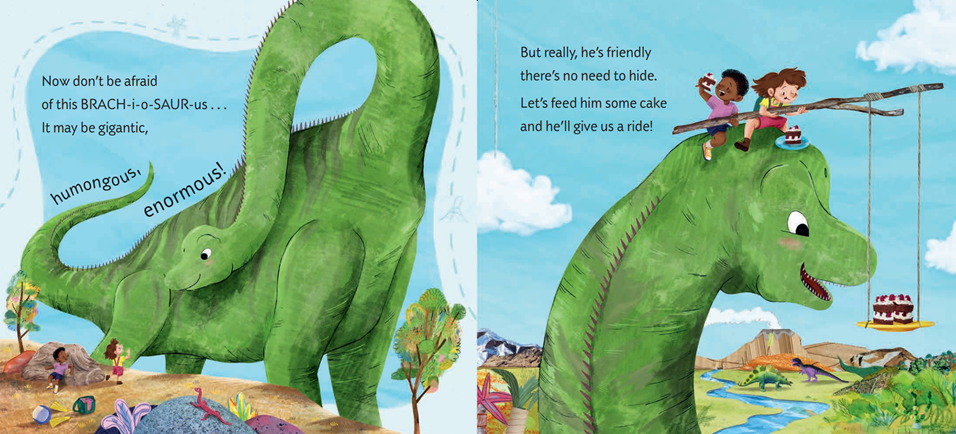
6. Do you hope your illustrations - which look hand made - will encourage children to create their own 'small worlds'?
I really hope the illustrations inspire children to make their own small worlds, and to get involved with art or any other form of creativity. There is so much we can learn from play, and so many skills that we can learn from making art which will stay with us and enrich us throughout our lives, so if the My Small World books help to foster and encourage that, then I think they will have been successful.
7. What other picture book projects are you working on currently?
I've just sent off the final artwork for the second My Small World book, and there will be a third on the way after that, too.
I also recently completed the illustrations for a non-fiction picture book which will be releasing in the US next year, and I'm currently working on my fourth author-illustrator picture book, an illustrated retelling of a classic story by an incredible writer, my debut author-illustrator middle grade series, and am soon to start working on a couple of other projects I'm quite excited about.
Oh, and Grandad's Pride, the sequel to my debut picture book Grandad's Camper, has just published this June! So there's just about enough to keep me busy...!
 My Small World: Dinosaurs
My Small World: Dinosaurs
 Thank You for the Little Things
Thank You for the Little Things
